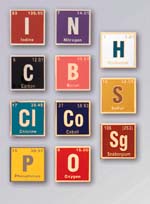 by Preston MacDougall August 07, 2006
So says the caption to a yellowing cartoon posted near my desk. An Erlenmeyer flask in the foreground, two men wearing lab coats are speaking. As only cartoonists can, their hairstyles are efficiently rendered with simple black lines - in this case none are parallel. By giving Burt more hair lines, he is obviously younger. And by judicious placement of the elder's hair lines, he bears a resemblance to Albert Einstein. Not too much though. That would ruin the joke.
One of the mysteries of humor is that blending truth and absurdity often results in a reaction of amusement. In the case of the yellowing cartoon, the truth is that Einstein has become an icon for a modern-day wizard, and as everyone knows, you don't become a wizard overnight. It takes years of practicing the "black art". Harry Potter is the exception, of course, and that brings me to Nicolas Flamel. In J. K. Rowling's introductory book, Flamel is named as the very old creator of the "Philosopher's Stone." There actually was a dramatic character named Nicolas Flamel. In the 14th century, when practitioners of alchemy were spreading across Europe, but before they became popular subjects of the Dutch masters, Flamel claimed to posses secret knowledge of a Red stone that transmuted mercury into pure gold. Like Rowling, Flamel apparently knew that drama made a fantasy much more marketable. His secret knowledge was supposedly gleaned from a dying Jewish physician in Islamic Spain, who told of his mastering of transmutation thusly: "a thing most difficult. Above all things in the world. But in the end I had that also, after long errours of three yeeres, or thereabouts, during which time I did nothing but study and labour." Like Rowling today, Flamel's story, and story-telling ability, made a lot of money. Though not by the method sought by alchemist's - bullion from base metal. They made it the old-fashioned way - they earned it. The history of alchemy, from its earliest beginnings in Classical Alexandria, where it was known as khemeia, or "the Egyptian art", is masterfully recounted in Paul Strathern's book "Mendeleyev's Dream: The Quest for the Elements" (published by Berkley Books in 2000). Paul Strathern's book may not have earned as much money as any in J. K. Rowling's series, but it has definitely earned the praise that I give it when I start my freshman chemistry class each year. The book's brief mention of Flamel, which I drew upon earlier, makes a literary connection to a surprising number of today's students, but the following passage gets the attention of everyone. It describes happenings in 17th century Hamburg, Germany, when the new scientific philosophy was transforming alchemy itself into what we now call chemistry. "Brand began a prolonged and extensive investigation of the properties of human urine, which must have sorely tried the patience of his well-to-do wife, to say nothing of the neighbours. He collected fifty buckets of human urine, which he then allowed to evaporate and putrefy until they 'bred worms'. This he then boiled until there was a pasty residue. When he left this in the cellar for some months he found that it had fermented and turned black. Doubtless with the entire neighbourhood now up in arms, Brand proceeded to heat the black fermented urine concentrate with double its weight of sand in a retort, whose long neck was plunged into a beaker containing water. The final distillate collected under water in the beaker was a transparent waxy substance. When removed from the water it glowed in the dark, and even sometimes spontaneously ignited, giving off dense white fumes. He decided to name the new substance phosphorus, from the Greek phos ('light') and phorus ('bringing')." There is a practical benefit to telling this story, since freshman students often are not very familiar with the atomic symbols and properly spelled names of elements other than oxygen, hydrogen and carbon. For instance, despite the similar phonetic beginnings of fluorine and phosphorus, my students will forever remember which one starts with P.
On the Web:
Publish A Letter on SitNews Read Letters/Opinions Submit A Letter to the Editor
|
||
